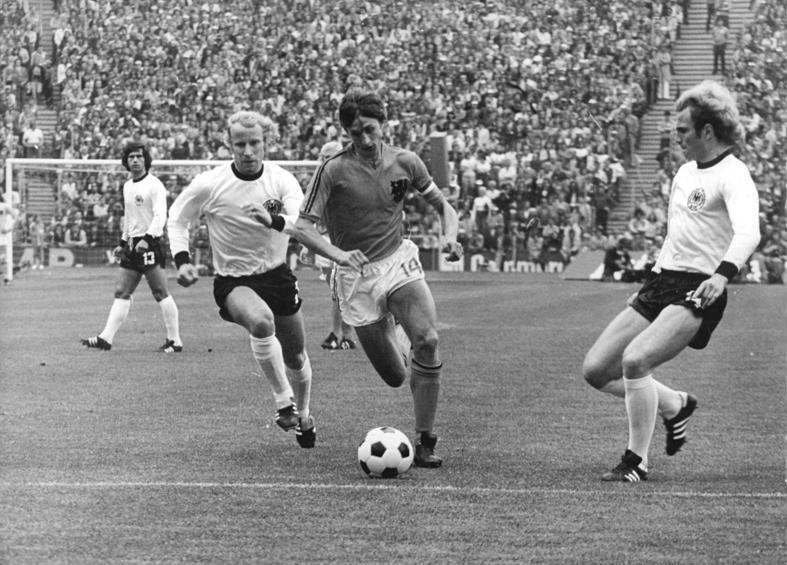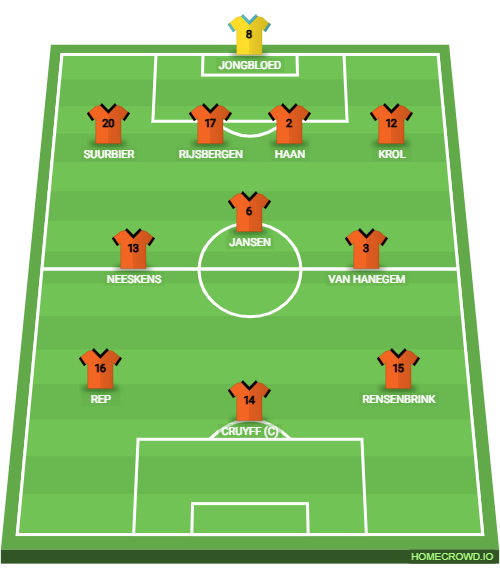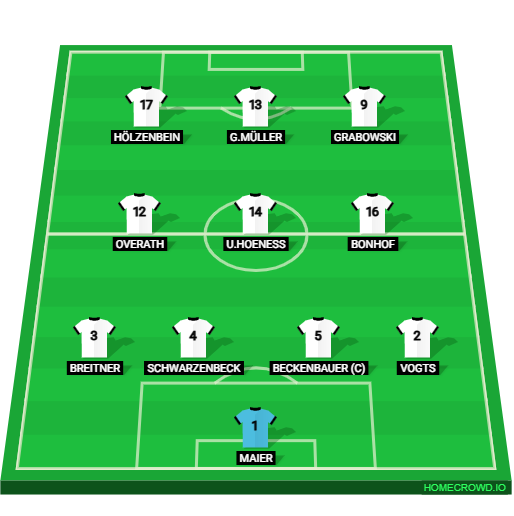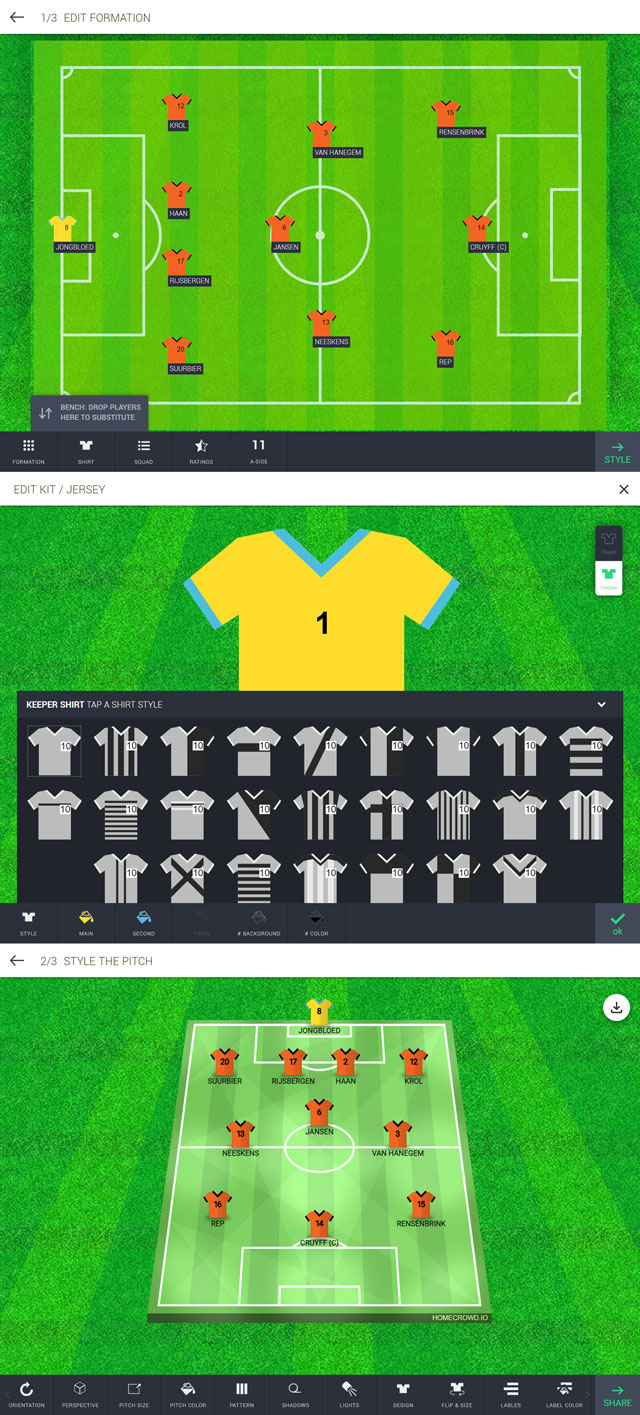Total Football Meets German Efficiency - WC 1974
A Tale of Two Giants: Johan Cruyff's Dutch vs. Franz Beckenbauer's Germans
As the 1974 World Cup unfolded, two teams charted their courses to Munich, each bringing unique flair and promise to an impending classic.
The Netherlands, the tournament's darlings, showcased a mesmerizing blend of intricate play, captivating audiences with their pioneering approach to Total Football.
Despite a solitary draw against Sweden, their journey was an emphatic testament to footballing genius. Guided by the marvelous Johan Cruyff, the Dutch team demolished Argentina 4–0, displaying remarkable pressing combined with a masterful offside trap. Another pivotal encounter, this time against World Champions Brazil, saw them further endorse the supremacy of Total Football, as second-half strikes from Johan Neeskens and Cruyff secured the Netherlands a berth in the grand finale.
He was a leader of men, a dominant presence who could bring the ball out with grace and skill. But I tell you this: he broke my heart. As an eight-year-old, I watched the 1974 World Cup Final between West Germany and Holland and I was supporting the Dutch. I cried my eyes out when they lost. I was very sad, but now I understand all about the brilliance of the Kaiser.Eric Cantona on Franz Beckenbauer
Conversely, hosts West Germany navigated a more challenging route. A politically charged encounter against East Germany witnessed the West face an unexpected hiccup, succumbing to a late Jürgen Sparwasser goal, granting the East a historic victory.
In another nail-biting affair against the Poles, it remained a stalemate until the 76th minute when the indomitable Gerd Muller finally shattered the deadlock, propelling the hosts to a 1–0 victory.
As these two footballing titans readied themselves for their rendezvous at the Olympiastadion, anticipation surged to unprecedented heights. The preamble to the final was laden with electrifying excitement, with fans and analysts alike on tenterhooks, keenly awaiting a face-off between these two behemoths of the footballing world.

In the luminescent era of the 1970s, the Dutch team, under the leadership of Johan Cruyff and Rinus Michels, painted the football canvas with the hues of Total Football.
This avant-garde approach was a symphony of perpetual motion, fluid roles, and relentless offensive vigor. It was not merely a tactic; it was an orchestra where every player knew every note. Each individual, regardless of his nominal role, was a jack of all trades, weaving between offense and defense with seamless grace.
Cruyff was the maestro of this style, a chameleon on the pitch who could create, dribble, and score with equal aplomb.
The hallmark of their game was an aggressive press, pinning their opponents in their half, coupled with a silky transition into attack, orchestrated by deft touches and visionary passes. Traditional roles melted away in their system, breeding an unpredictability that left adversaries chasing shadows.
Imagine Cruyff, ostensibly a center forward, gracefully drifting deep, orchestrating a play, and then darting into the box to elegantly finish a cross. This holistic approach to the game engaged every player in the ebb and flow of attack and defense, crafting a spectacle that was a conundrum for rivals.
Netherlands Lineup
The 1974 Dutch football team, masterminded by the visionary coach Rinus Michels, became a phenomenon in the football world. This team boasted the talents of some of the era's most brilliant players, such as Johan Cruyff, Johan Neeskens, and Willem van Hanegem.
Johan Cruyff, often referred to as the "Flying Dutchman," was not only the heartbeat of the Dutch team but also the quintessential representation of the revolutionary Total Football. His unmatched vision, agility, and skill solidified his status as one of the game's iconic figures.

Johan Neeskens, lauded for his relentless work rate and technical mastery, was pivotal in the midfield. His versatility meant he was a force both in defensive duties and in advancing play, becoming an integral part of the Dutch setup.
Willem van Hanegem, held in high regard as one of the Netherlands' finest, was famed for his precise passing ability and masterful ball control. Defensively, van Hanegem's presence was undeniable, with his steadfast tackles and readiness for physical duels, even if speed wasn't his primary strength.
The German national team, reigning European champions, carved out a legacy underpinned by a great balance of technical brilliance, efficiency, tactical discipline, and indomitable spirit. Far from the artistry of Total Football, the Germans were the masters of seamlessly blending the roles of individuals into a collective unit that often proved unstoppable. Spearheaded by the likes of Franz Beckenbauer and Gerd Müller, the team's approach was meticulously orchestrated.
Beckenbauer, the legendary 'Kaiser', embodied the German football philosophy - a sweeper who could defend with tenacity and transition into attack with elegance. Gerd Müller, nicknamed 'Der Bomber', was a goal machine with an uncanny knack for being in the right place at the right time, translating half-chances into goals.
The German side was synonymous with resilience paired with outstanding skills. They might be behind, they might be under pressure, but they would never be out. Their ability to claw back into games made them formidable opponents. Matches against them were not just tests of skill, but also tests of will. In this German machinery, every cog, from the goalkeeper to the striker, functioned with unyielding determination and cohesion, crafting a football narrative that was as compelling as it was effective.
Germany Lineup
The 1974 German football team, led by manager Helmut Schön, was a formidable force in the world of football. The team boasted some of the most talented players of that era, including Sepp Maier, and Ballon d’Or winners Franz Beckenbauer and Gerd Müller.
Franz Beckenbauer, also known as “Der Kaiser”, was a versatile player. He began his career as a midfielder and later cemented his legacy as a central defender. He is often credited with pioneering the role of the modern sweeper or “Libero”.

Sepp Maier, celebrated for his sharp reflexes and agility, stands as one of football's premier goalkeepers.
Gerd Müller, a striker with a penchant for clinical finishing, is widely recognized as one of the most prolific goalscorers in the sport's history.
In Munich's Olympiastadion, the atmosphere was electrifying as two European powerhouses, the Netherlands and West Germany, squared off in a match that would be etched in football history.
From the outset, the stage was set. Johan Cruyff and Franz Beckenbauer, football legends in their own right, faced each other for the coin toss, encapsulating the grandeur of what was about to unfold.
The Netherlands struck early, drawing first blood. In a mesmerizing display of his signature style, Cruyff danced past Berti Vogts and was tripped by Uli Hoeness in the box. Johan Neeskens confidently dispatched the resulting penalty, giving the Dutch a dream start.
Vogts, seemingly overwhelmed by Cruyff's prowess, earned himself a yellow early in the game, but West Germany retaliated with intent. Breitner tested the waters with an ambitious shot that soared high, signaling the Germans' intent.
As the first half progressed, the Dutch goalie, Jongbloed, showcased his brilliance, thwarting attempts by Vogts, who grew stronger with each passing minute, and later saving a beautifully crafted freekick by Beckenbauer.
The match's momentum shifted when Wim Jansen committed a foul on Holzenbein in the Dutch area. Seizing the opportunity, Paul Breitner coolly converted the penalty, equalizing for the hosts.
Johan Cruyff and Franz Beckenbauer, two players that they're valuing at over a million pounds, toss up to find out which way they're going to kick in this, the supreme moment: Kickoff Netherland versus Deutschland in the World Cup final, 1974.
Johan Cruyff with one of his famous accelerations shakes off Berti Vogts, goes past the defensive line and is tripped in the box by Uli Hoeness. The referee awards a penalty to Holland.
Johan Neeskens converts the penalty with a ferocious shot to the middle of the goal, putting Holland ahead early in the game.
Berti Vogts struggles to handle Cruyff and gets a yellow card early in the game.
Breitner shoots over the goal.
Wim Jansen brings down Holzenbein in the Dutch penalty area. The referee awards a penalty to West Germany. Paul Breitner steps up and scores, making it 1-1.
Miraculous save from Jongbloed against Berti Vogts who gets stronger in the game.
Wonderful freekick by Beckenbauer. He just chips the ball over the wall, but Jongbloed saves it.
Missed opportunity for Holland! Johan Cruyff breaks clear and passes the ball to Johnny Rep, who stabs the ball straight at German keeper Sepp Maier.
Two minutes before halftime, Jürgen Grabowski initiates a dangerous attack, leading to Gerd Müller’s decisive goal. Gerd Müller stops the ball inside the box with a great first touch and scores on the turn, putting West Germany ahead.
The first half ends with West Germany leading 2-1. The Dutch players express their frustration with the referee for awarding a ‘soft’ penalty to Germany.
Breitner saves on the line.
Sepp Maier saves against Van Hanegem.
Miraculous save by Maier! Johan Neeskens unleashes a ferocious volley after a corner that is turned away by Sepp Maier.
Rep is guilty of an miss as he fails to connect at close range with a low Wim Suurbier right-wing cross.
Neskens shoots another one from outside the box just past the left post.
Germany wins the World Cup!
In a moment of sheer brilliance, Jürgen Grabowski masterminded a move that found Gerd Müller, and with his typical finesse, Müller found the back of the net. Going into halftime, West Germany held a slim lead, and the Dutch contingent displayed palpable frustration, particularly over the penalty decision.
The second half was no less intense. Breitner put on a defensive masterclass with a critical save on the line, and Sepp Maier, the German sentinel between the posts, made his mark with a breathtaking save against Neeskens.
The Netherlands, ever persistent, saw Rep squander a golden opportunity, failing to connect with a Suurbier cross. Neeskens, in another attempt to level the score, unleashed a shot from distance, but to no avail.
When the final whistle rang out, it was West Germany who stood tall, clinching the title in a match that exemplified the very essence of the beautiful game.
Johan was the better player, but I am a world champion.Franz Beckenbauer on Johan Cruyff
In the theatrical setting of the 1974 World Cup, the Dutch ensemble dazzled with unmatched flair. Their scintillating displays against luminaries like Argentina and former titans, Brazil, had not only won matches but hearts too.
Many in the Netherlands still shake their heads in disbelief at the final's outcome. For them, it was a game of dominance, especially in the second half, as relentless orange waves charged at the German fortress time and again. But as the saying goes, football is a game of inches and moments.
From the first whistle, the Oranje's intent was palpable. However, mirroring a recurring narrative of Dutch teams through history, they often lacked the clinical finishing that crucial moments demanded. Numerous attacks in the second half showcased their artistry, but the all-important final strike frequently missed the mark or was parried away by the unyielding Sepp Maier, the German sentinel, who continually thwarted the Dutch and kept his team in the game.
The Dutch pressing game, which had been a nightmare for teams like Argentina, found its match in the Germans. Beckenbauer, the German Kaiser, with his innate vision and elegance, often evaded the Dutch press, setting the tone for his team. Berti Vogts, initially outpaced by Cruyff's genius, adjusted as the game unfolded, a testament to German adaptability and will.
Total Football, as poetic as it is on the pitch, has its vulnerabilities. Historically, the Dutch side, in their pursuit of playing the beautiful game, left gaps exploitable on the counter. Their game wasn’t just about winning; it was about winning with grace, style, and flair. Even with a lead, they wouldn't bunker down; it wasn't the Total Football way nor the Dutch spirit.
And they were up against a German side that was a harmonious blend of skill and resilience. While the Dutch squandered opportunities, the Germans were the antithesis. They had Gerd Müller, a player who needed but a whisper of a chance. Coupled with a defense willing to fight for every blade of grass and the heroics of Maier, they weathered the storm. The finale was not just about contrasting styles, but also contrasting efficiency.
Dive into football history and craft your own lineups from classic matches. Relive iconic moments by designing formations from legendary games using the lineup builder on Homecrowd.

References
- David Winner on the Big Bang of Total Football - Football Paradise
- Eric Cantona's Perfect XI - FourFourTwo
- How Franz Beckenbauer Decided the 1974 World Cup Final - Beyond The Last Man
- Historical Lineups
- World Cup Rewind: 1974 and the Second Star - DFB
- 1974 FIFA World Cup - Wikipedia
- [1]Endspiel BRD gegen Niederlande 2:1: Bundesarchiv, Bild 183-N0716-0314 / Mittelstädt, Rainer